Here’s how to determine what size storage building will best suit your stuff, style, property, and neighborhood.
Size is one of your most important decisions when buying a backyard metal shed. Surprisingly, the answer to “How big?”—or “How small?”—isn’t simple or cut and dried. Of course, you’ll need to consider the size of your property and how you hope to use the shed, but even those factors have variables. Then there are other considerations that may not readily occur to you.
Here’s how to determine what size storage building will best suit your stuff, style, property, and neighborhood.
Fear not: This guide will help you put the pieces together so you end up with the right square footage to serve your needs. Just be sure to review these five considerations before you speak to your shed dealer.
1. How You’ll Use the Shed
So many folks today are discovering that a metal shed can serve as much more than storage. There are a number of ways to enjoy a shed, as long as it’s big enough to suit your purpose. For instance, if you’re hoping to set up a workshop, your metal shed will need shelving for supplies and storage space for power tools, but you’ll also want a bench large enough for assembling projects and enough room for you to move around comfortably.
Remember that shed size isn’t just about length and width—you also have to think about height to make sure you can fit everything in it.
2. What the Shed Will Hold
There’s no denying that a backyard metal shed is a homeowner’s ultimate storage solution, so get a handle on what you expect to keep in there. If it will be devoted to bulky items like a motorcycle or ATV, your shed should be at least 12 feet by 10 feet. But the smaller things add up—and eat up space. Most people underestimate their storage needs, forgetting, for instance, that they’ll want to stash off-season sports equipment, lawn furniture, or holiday decorations in the shed when not in use. And, once again, account for “me” space so you won’t feel cramped while you’re organizing, arranging, and accessing your stuff. Use the LP size selector tool to estimate your shed’s size based on your particular storage needs. The calculator includes measurements for common items like lawnmowers, grills, and tools to make the determination easy.
3. Room for Growth
It might not be a bad idea to size up a bit for the future. After all, you may need a larger footprint to add to your tool collection, or your kids may get into different sports requiring bulkier equipment. Or, over time, you may change how you use your metal shed entirely, turning what was once used solely for storage into a gym, office, or shop. Keep in mind that you needn’t stick to a standard size—shed builders are often happy to accommodate custom requests.
4. The Size of Your Yard
Perhaps you dream of a metal shed as big as a palace, grand enough to hold your possessions with room to spare for you to pursue your passions. Great! Just be sure it will fit in your yard. Generally speaking, a 12-foot-by-12-foot shed will suit a large yard, while an 8-foot-by-10-foot one is better for a medium-sized yard.
In selecting the size of your metal shed, you’ll need to think beyond the building itself. Keep in mind that the foundation should be one foot larger than the shed on all sides. You’ll also need to account for setbacks from property lines, roads, or floodplains. Aesthetics are important, too: The shed should look in scale with your property and your home. (Tip: If you want a large shed, consider setting it toward the back of your yard, where it won’t compete with the house.) Finally, think about the landscaping and other features of the yard. Will your metal shed sit nicely between those two trees? Will it overwhelm the kids’ swing set? Your existing yard layout may influence the optimal size of your shed.
5. Community Regulations
Sure, your metal shed is your castle, but your local municipality and homeowners association (HOA) may very well have a say in its size. Most localities require you to register the placement of a metal shed with the zoning office before installation, and larger structures might call for a building permit, so plan ahead. HOAs typically set limits on the footprint (for instance, no more than 1 percent of your property) and the height of your shed. Refer to your HOA’s covenants, conditions, and restrictions for details before buying a metal shed.
